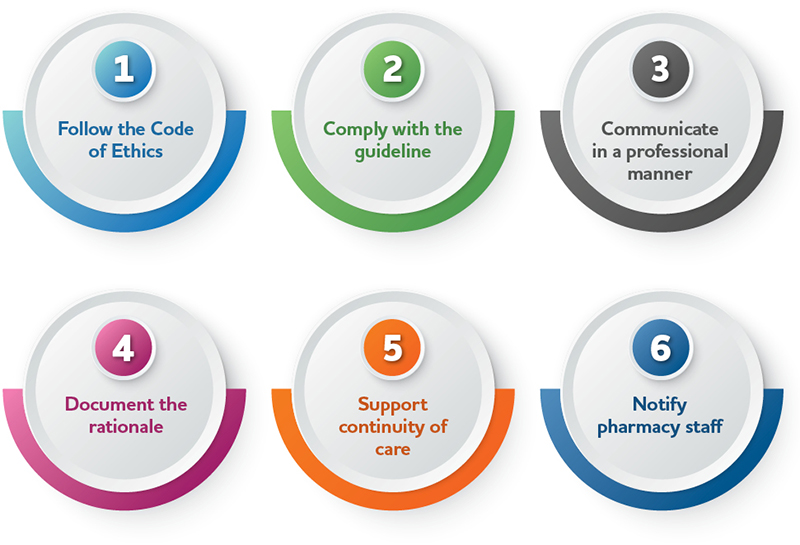Practice Insight explores concerns reported to the College as part of the complaints and reports process that present learning opportunities for pharmacists and pharmacy technicians. This example reminds registrants that care must be taken when ending the patient relationship by exploring two separate complaints reported to the College that resulted in different outcomes.
Case Scenario #1:
A patient took a prescription for a compounded topical product to a pharmacy where the pharmacist indicated that it would take two to three days to prepare. Despite many calls, the patient did not hear from the pharmacist for nine days. The patient informed the pharmacy that she had to pick up the medication as the pharmacist had already billed her insurance. In response, the pharmacist was confrontational, asking whether the patient really wanted the prescription. When the patient pointed out that she had already waited many days, the pharmacist said that he “did not want to deal with this anymore”, would reverse the insurance claim and would not provide the patient with the medication.
A panel of the Inquiries, Complaints and Reports Committee observed that the pharmacist did not provide timely patient care and failed to communicate with the patient when he was delayed beyond the original two to three days. The panel noted that the pharmacist failed to abide by the requirements in the College’s guidelines on ending the pharmacist-patient relationship by not providing an appropriate rationale, the proper notice, and an opportunity to obtain another pharmacy’s services. In particular, the panel noted that the prescription in this case would only be available at a pharmacy that does specialty compounding, which presents additional access challenges for the patient.
As a result of the pharmacist’s failure to put the patient’s best interests first and the improper withdrawal of his services, the panel issued the pharmacist an oral caution.
Case Scenario #2:
A patient complained that her pharmacy had inappropriately terminated services following issues such as not having the proper labels on her medications, and not receiving the full 90 days of her medications. While she acknowledged raising her voice in frustration, she indicated that the pharmacy had not provided proof of examples of her disrespecting pharmacy staff.
A panel of the Inquiries, Complaints and Reports Committee noted that none of the patient’s concerns were supported by the information and documentation provided by the pharmacist. The panel stated that the registrant had ample evidence for deciding to terminate the pharmacist-patient relationship, including many incidents of staff being subject to verbal harassment, swearing, name-calling and aggressive behaviour from the patient. Prior to making the decision to terminate the patient relationship, the registrant also consulted with colleagues and the pharmacy manager.
The panel felt that the registrant had appropriately terminated the relationship for the reason that the pharmacist believed that patient had lost trust in the pharmacy staff to effectively care for her. He informed the patient of the decision in writing and on the telephone, including explaining why, allowed her ample time to locate another pharmacy and advised her family physician. Given that the termination of the pharmacist-patient relationship was handled professionally and in compliance with the College’s requirements, the panel took no action against the registrant.
Learnings for Registrants
Six Things to Do When Ending the Pharmacist-Patient Relationship

- Recognize the care and consideration required by the Code of Ethics and the Ontario Human Rights Code. Under the Code of Ethics, registrants can only consider ending the patient relationship when the relationship is compromised or issues cannot be resolved, they have considered the condition of the patient and the availability of alternative services, and sufficient notice has been provided. Additionally, the rationale for terminating care must not be due to a prohibited ground within the meaning of the Ontario Human Rights Code.
- Read and comply with the requirements of the Guideline – Ending the Pharmacist Patient Relationship. Any registrant considering terminating the patient relationship should ensure they review the guideline.
- Communicate the decision to the patient in a professional manner. In the first case above, the pharmacist did not communicate professionally with the patient, only made the determination by telephone and did not provide a rationale. Pharmacists must communicate the decision to terminate services in writing. If also communicating in person or via telephone, they should ensure the privacy of the conversation while making sure both the patient and staff members are safe and maintaining a professional demeanor.
- Document the rationale for the decision. As demonstrated in the second case above, the documentation by the pharmacist is important to show that the decision has been made thoughtfully. If questions or concerns are raised later, proper documentation can also confirm the actions taken.
- Provide the patient with time to find a new pharmacist. The amount of time to provide the patient to find a new pharmacist will depend on their condition, needs and availability in the local community. As demonstrated in the first case above, patients requiring specific pharmacy services, such as compounding, may require more time or assistance to find alternatives. The pharmacy should cooperate with the smooth transition of information/prescriptions to the next provider.
- Ensure all pharmacy staff are aware of the decision. Staff members should be aware of the termination of the patient relationship, including when the transition period will end and what to do if the patient continues to seek services or communication from the pharmacy.
Ultimately, registrants who are considering terminating the patient relationship must ensure that they have a good reason for doing so, provide proper notice and support the continuity of care for the patient.













